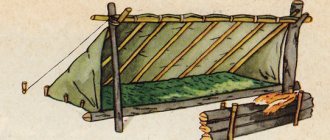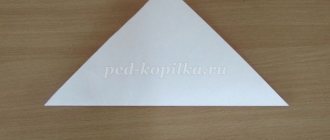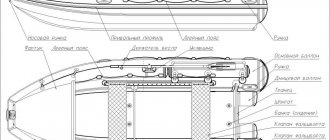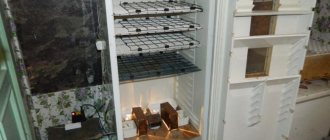Night sounds of the forest, the cozy crackling of a fire and sparks flying up to the starry sky... Perhaps there is not a single person who will not be touched by such a picture. The romance of distant travels, overnight stops in the wilderness, hermits in the taiga, hunters, fishing huts, many in childhood read adventure novels that tell about this way of life. But there are many people for whom such romance is an integral part of their everyday life. Geologists, fishermen, commercial hunters. It is about such fishermen and how they live in the taiga that will be discussed further.
Life in the taiga
Of course, life and work in the taiga consists of far more than just romantic moments. This is not easy, daily work, and there is very little time left for romance. Nevertheless, a person periodically needs rest. Eat, sleep, and what if we are talking about the rainy season or winter, which is very harsh in the Siberian taiga? You need somewhere to dry off, warm up, and cook food. After all, you won’t have to clear the area of deep snow every time for a fire. Yes, and supplies need to be stored somewhere, and for this you will need a dugout or hut in the taiga, photos of which are presented in this article.
Winter hut in the ground
If there is little snow on the ground, you can make a shelter with a depression. Earth is a good thermal insulation material that will provide shelter from the cold. But frozen ground is extremely difficult to dig (digging, chiseling).
Your best bet is to find an existing hole in the ground, such as a hole left by a large old tree falling (when the tree falls along with its roots and soil). Adjust this hole to the required size, and build a canopy of one kind or another on top. To make the frozen ground more pliable, you can light a fire and warm it up.
Important: The construction of such a shelter in winter is associated with a lot of physical activity, as a result - clothes become wet from sweat, and then hypothermia may follow. In this case, it is better to take off some of your clothes in advance.
Dugout
The simplest and fastest solution would be to build a dugout. Yes, equipping such a shelter does not require much time, any special skills or significant effort. It is also quite warm. But there are also many disadvantages. In such a shelter it is dark, damp and quite problematic to equip a normal stove for heating. A dugout is more suitable for temporary shelter. After all, a fisherman walking around his area will often need places to stay for the night. Moreover, the area of the site may be of such dimensions that a complete walk-through will last not one day or two, but a week or more. In this case, temporary dugouts are set up at a distance of a day's march. Well, a real taiga dweller will definitely build a log hut in the taiga as his main home.
How to build a hut in the forest in winter
The main task of a winter shelter is to preserve heat. Materials with low thermal conductivity should be used: snow, spruce branches, straw. In addition, it is important to reliably protect yourself from the wind.
The simplest solution in winter is a snow cave:
- You need to find a large enough snowdrift and dig a hole in it. It is better not to make a large hole, otherwise it will be difficult to warm it up.
- You should lay spruce branches or straw underneath, otherwise your clothes may get wet from the melting snow;
- You can heat the interior with fire (it is better to use gas or dry fuel, but you can also try to make a fire), then you should make a hole in the roof for ventilation;
- In case of strong winds, the entrance can be closed, leaving small openings for fresh air to enter, although in this case there is no constant possibility of getting out.
The main task of a winter hut is to keep warm.
A more comfortable, but also more complex option is the famous Eskimo invention - the igloo . A well-built igloo allows you to survive frosts down to -40°.
- You will need to cut blocks from dense compacted snow and build a house from them. To save time and effort, it is best to build an igloo on a slope, then fewer blocks are needed;
- Usually the blocks are laid in a circle, so that the top blocks gradually move towards the center, forming half a sphere. In this case, the builder himself is in the center of the building, laying blocks around himself;
- At the end there is an exit, and do not forget about the ventilation holes.
To avoid freezing in the winter forest, hunters also use a hut with a node . It is quite simple to build:
- Build a lean-to hut that will protect you from the snow;
- A node is made on the open side of the canopy: two long logs are laid on top of each other and secured in this position with pegs or supports. A fire is lit between the logs along the entire length of the structure;
- Nodya burns slowly and provides a stable supply of heat to the shelter, allowing you to survive a frosty winter night.
Taiga hut
There is no point in arguing about the advantages of a log hut as a winter hut. It will perfectly protect against autumn slush and winter cold. It is dry, warm, light and definitely more comfortable and cozy than in a dugout. In addition, a wooden hut will serve not only as protection from weather conditions, but also from wild animals. In general, both a commercial hunter and an ordinary hermit who, instead of the bustle of people, chose unity with nature as their main home, and any sane person will give preference to a log building.
Peculiarities
Any commercial hunter who has a plot of forest at his disposal sets up a network of winter huts. Usually the network consists of a main hut, where you can live permanently, and small winter huts, in which you can spend the night along the route. Therefore, the distance between winter huts should be equal to one day's march.
The main purpose of a hunter's hut is a roof over your head and strong walls that can protect you from severe frost, angry blizzards, torrential winds (a common option for insulating walls with moss is shown in the figure below) and the dangers of the night taiga (including bears, so you need to think about additional protection of the house). In the winter hut there is always some non-perishable food and a supply of firewood for a week. The doors in such houses are not closed so that every hunter, forester, mushroom picker or tourist who gets lost in the taiga can survive in harsh conditions.
By the way, not only hunters live in small huts, but also hermits or indigenous peoples of the north, who know how to build a hut in the forest very quickly. More often, of course, it is commercial hunters who are engaged in the construction of winter huts.
Selecting a location
So, permission has been received, and the next step is choosing a location for future construction. It is advisable that this be a small clearing near a pond or at least some source of water. If such a clearing could not be found, then you will have to clear the space for construction yourself. The felled trees will immediately be useful as building material, and the twigs and branches will be used for firewood. You will have to suffer a little with the stumps left after cutting down, but no one in their right mind will uproot stumps by hand. It's easier to burn them. You also need to take into account the fact that there are no tall and dry trees close to the hunting hut in the taiga, since from a strong wind they can fall and overwhelm the building. We must not forget that you cannot build a hut in a lowland due to dampness and possible flooding. You should not build a building on a bare hill, since due to its exposure to cold winds there will be a problem with heat conservation. And in general, taiga housing, if it does not necessarily have to be carefully camouflaged, is worth more or less hiding it from prying eyes. Otherwise, you never know, different people can wander around the taiga.
Important Legal Issues
All land where forest-type vegetation is located, areas without forest but created for its restoration (clearings, clearings), lands in and near the forest belong to the state. The federal leadership develops forestry policy, distributes documents to localities, maintains a cadastre of forest lands, and makes decisions on changing the category of sites.
Is it possible to build a hut in the forest? Officially, a plot for construction in a forest can only be obtained if the category of land is changed. In the constituent entities, this is handled by the Forestry Department, and the transfer of land in undelimited territory is carried out by the Government of the Russian Federation.
To re-register land, you need to collect a large package of documents that will be considered at the local, regional and federal levels. The entire procedure can take up to a year or more. The process is complex and long. When submitting independently, there are no guarantees of results.
In many cases, it is easier to rent land for construction in the forest for 10-49 years. The tenant's responsibilities include improving the condition of the land, soil reclamation, environmentally friendly use of natural resources, and timely payment. On rented land you can grow seedlings, conduct scientific research, collect medicinal herbs and edible resources, establish apiaries, hunt, and cut down trees.
Free use of forest areas is possible. Upon application, you can receive a plot for a period specified in the law (usually up to 10 years). Servants of religion, northern ethnic groups, ordinary people for a certain type of activity (beekeepers can use the plots for up to 5 years), employees of organizations involved in forest protection and defense have the right to use the land free of charge.
Selection of trees for construction
Typically, the construction of huts in the taiga is made from coniferous trees. Of course, larch would be more suitable, since it rots much more slowly than conifers, but it still needs to be found in sufficient quantities. As a last resort, lay out the first crown from deciduous trees, and then continue with conifers. Cedar is also perfect for this purpose, since in a hut with cedar walls the air has a healing effect. There is no need to choose very thick trees. Fifteen to twenty-five centimeters thick logs will be sufficient. Practice shows that a raw pine log up to 25 cm thick and up to 4 m long will weigh about 120 kg. And since you will not be lifting the whole log, but only one edge of it, this weight will be quite feasible for an adult and healthy man. If such a weight still seems heavy, you can choose thinner trees. Of course, in this case you will need more of them.
Are hunting winter quarters illegal?
The issue of building winter huts on an undemarcated territory is an imperfection of the legislation. Commercial hunters work under a contract and quite officially; they are assigned hunting or fishing areas. In these areas, it is permissible to erect temporary residential buildings for overnight stays. It’s another matter if the houses are used illegally (by poachers) or for year-round living.
It turns out that it is possible to build a winter hut in the forest, although current legislation is still ambiguous on this issue. But to build a house intended for long-term living, you need to rent or buy land, and only then begin construction.
Of course, there are many illegal buildings in Russian forests. Some of them are even used for year-round living, but they were built by someone unknown and when, and are not registered anywhere, which means they are illegal and have no owner. Someone can appropriate or demolish such buildings with impunity.
Laying the log house
So, let's start laying the frame of the future hut in the taiga. The first crown can be placed directly on the ground, but it will be much safer to dig a depression of about fifty centimeters around the perimeter and fill it two-thirds with small stones. Compact the stones and place the first crown on top. For the first 2-3 crowns it is better to use thicker logs. Before laying, the logs must be cleared of bark. There are several ways to lay logs. The most famous are cutting into the paw, into the bowl and into half a tree. The easiest way to build a hut in the taiga is to cut half a tree. In this case, grooves in the logs are not made at the corners, but simply the floor of the log is removed, and a treated trunk is placed on top in the same way. Here you can also drill a hole in the logs and additionally secure them with a wooden spike. Chopping into a bowl looks a little more complicated. In this case, a transverse hollow is hollowed out in the upper log, with which it lies transversely on the lower log. If desired, you can also strengthen the logs with spikes, but this is no longer so necessary, since the crowns themselves turn out to be well secured. Well, the last method is cutting in the paw. This is the most difficult method and without some carpentry training a beginner will not be able to do it. By the way, in places where there will be windows and a door, despite the longitudinal hollow in the logs, it is imperative to strengthen the joints with wooden spikes. Since in most cases, hunting lodges are built from raw wood, in order to avoid significant deformation of the walls after drying, it is advisable, despite the type of log house, to additionally strengthen the logs with spikes. Well, with the walls it’s more or less clear. But there are also windows, doors, floor, ceiling and roof. Building a hut in the taiga without boards is possible, but it will not be quite a hut. Where can you get boards in the forest? Don't carry it with you. You'll have to make them yourself.
Different methods of laying crowns
How to build a hut? From the prepared materials, that is, logs, you first need to remove the bark. For debarking, a sharpened shovel, taiga ax or scraper is used. At the beginning of May, the bark is already peeling off well, but it is still better to use trees harvested in winter. Dried logs are harder to process, but they are much lighter.
The crowns can be placed “in the paw” or “in the bowl”. A simpler option is “half a tree”. The “bowl” method makes it possible to achieve a better fit of logs to each other, that is, the likelihood of cracks occurring is significantly reduced. Raw moss is placed between the logs. It is better to use raw wood, because it does not crumble, dries along with the logs and is a natural preservative that will slow down the rotting of the wood. You need to use more moss so that no gaps remain.
Additionally, you need to strengthen the corners and window shutters. The deep taiga forests are inhabited by bears, who often destroy the house from the corner. Planks with bristling points are often placed against the wall, window sills, along corners, behind the threshold and on the threshold. Hunters call them “hedgehogs.”
Making boards
Of course, we can’t count on even and relatively smooth boards that are made at sawmills. Nevertheless, we are quite capable of making a product that is quite similar to them and which we are not ashamed to call a board. All you need for this is a sharp axe, and for greater convenience you can make a wooden sledgehammer. It is necessary to choose a straight tree without large knots or twists in the trunk, plan several wooden wedges, make a small cut at the base of the trunk and drive a wooden wedge into it, gradually splitting the log along the fibers. A second cut is made nearby and the wedge is driven in again. Then the entire deck is split into boards, or as they are called - shingles. By the way, these boards have much more strength than those made on a sawmill in the usual way, since the wood fibers are not damaged. In this way, you can provide yourself with the necessary number of boards to build a roof, doors, floors and other necessary parts.
General architectural and spatial solutions
The style of a hunting lodge dictates very specific requirements for the structure being built. The appearance and interior design should speak about the functional purpose. When decorating the facade of a house, there will be details such as figured roof outlets, which professional carpenters call “roosters.” It would be nice to include in the project an open terrace at the level of the first or second floor, if available.
Two-story hunting lodge with an open terrace on the second floor
The interior of the hunting lodge is designed in accordance with the tastes of the owner. A set of required attributes for this style:
- the presence of a main hall with a fireplace, the walls of which can be decorated with hunting trophies of the owner of the house;
- the presence of a bathhouse or sauna;
- one or more bedrooms.
An example of the interior design of a hunting lodge.
Typically, such a lodge is also a guest house; accordingly, rooms for temporary residents are needed.
Rounded logs or beams have significant advantages over other building materials. The interior does not require additional finishing. On the contrary, exposed wood once again emphasizes the style of the building and its functional purpose. When determining the number of floors, preference is usually given to two-level buildings, which are somewhat more complex in design, but more efficient in terms of thermal energy conservation.
Typical layout of a two-story hunting lodge
Roof
A hut in the taiga can have either a single or double roof with an attic. Single - it is done faster and easier, but with an attic it is many times more convenient and practical. Firstly, the hut becomes many times warmer, and secondly, additional space appears for storing various things and supplies. In the warm season, you can dry hay and all sorts of herbs there. The roof is made as follows. First, the ceiling is laid out of shingles. The cracks between the boards are lined with moss. You can sprinkle it with earth on top or cover it with plastic wrap. Next, in front and behind the hut, two supports are attached to the top, the ridge rests on them and on the sides, two or three on each side. Then we cover the entire structure with shingles, we also caulk the cracks with moss, there is no need to spare the moss, and on top everything is covered with plastic film. It is not heavy and you can take it with you in sufficient quantity.
Insulation of floors and laying of boards
How to build a hut in the forest with your own hands? After the walls were built, all that was left was the floor and roof. Floorboards are not laid on damp ground. The bottom layer is filled with loose earth or sand mixed with moss, stones of different sizes, polyethylene or any available insulation. Moss is placed again directly under the boards so that there are no gaps.
Bake
The stove is one of the most basic internal elements of a hunting hut in the taiga. There are two types: metal (potbelly stove) or brick. The stove can be heated either in a black way (without a chimney), which is extremely inconvenient, or in a white way - with a chimney. Installing a metal potbelly stove is quite simple and does not require any special skills. Building a brick oven is not a very simple matter, and besides, you will first need to make raw bricks from clay, which can be found near the nearest body of water. In terms of its properties, a potbelly stove differs from a brick stove in that it heats up very quickly. Accordingly, it quickly warms up the room. But after the fire goes out, it cools down just as quickly. Therefore, you need to constantly ensure that the fire does not go out. But a brick oven, on the contrary, warms up the room not so quickly, but also cools down much longer, as a result, the heat does not leave the room for a long time. It is better to place the stove in the middle of the room. This way it will warm up the hut faster and more evenly, plus it will be convenient to dry things around it. And in terms of fire safety, this placement option is safer. Photos of hunting huts in the taiga with and without a stove can be easily found and viewed in the article.
How to build and insulate a roof
How to build a hut in the forest with your own hands? The most difficult thing for inexperienced hunters who started building a winter hut is the roof. Roofs can be single-pitch or gable, with or without an attic. It is better to build with an attic, because in the summer you can dry herbs there, and in the winter it is warmer. At any time of the year the attic can be used as a storage room.
The attic roof can be laid not with boards, but with small logs or halves. Moss should be laid between them, earth should be poured on top and covered with polyethylene. For the intermediate roof (this is the floor of the attic), the film is not necessary, but then you need to use more moss to provide good protection from rain. The cold is no longer so terrible, because due to the attic there are actually two roofs.
How to quickly build a hut in the forest? If you need to build a house quickly, you can build a regular roof without an attic, but it will be colder in such a room. It is better to lay the top of the logs with moss and cover them with earth in order to somehow retain more heat inside.
If desired and if necessary, you can camouflage the roof with a special camouflage net. You can do this yourself. You need any mesh for weaving the base (rope or fishing, but not fishing line, because such a structure will not last long), pieces of moss, leaves, rags, dense ribbons of dark green, gray, brown or white. Camouflage elements are woven into the structure of the network. It is advisable to tie each one not in the center, but with a tendency towards asymmetry.
Mice and larger animals
The hut must be equipped with a tightly closed door, locked from the inside, to prevent free access for wild animals. Also, inside the ceiling there should be hooks for hanging supplies, since if you place them on shelves or hang them on the wall, you risk losing everything, since mice are excellent acrobats, and in this case they can easily get to the food. To catch mice, you can use one and a half liter plastic bottles. They need to be strengthened at an angle near the corner and the wall with the neck up. The mouse will definitely get inside the bottle, but will not be able to get out back.
Unwritten rules of behavior in hunting huts
Unwritten rules have long been in force for those who hunt in the taiga and hunting huts left unattended for some time, in accordance with these rules, must have a supply of firewood, salt, matches and essentials. It is not customary to lock such houses. The door should be tightly closed, but not locked. Perhaps someday someone will be able to save their life thanks to this. Also, if you need to spend the night in such a hut, behave decently in it, as if visiting a good friend. Don't litter, be careful with other people's property. Before leaving, clean up after yourself, hang supplies from the ceiling, and if you have your own, don’t take the owner’s. Renew your firewood supply. A hunter's hut in the taiga must be ready to meet the next wanderer. Also, someday some taiga traveler will take care of your house. In the taiga it is customary to help and help each other out.
What is needed to build a hut
A hut can be built from different materials, depending on the area. Usually this:
- branches and sticks;
- spruce branches;
- straw;
- leaves;
- tree bark;
- plant stems;
- earth and clay;
- snow.
You can use “artificial” materials that you brought with you or found in the forest. At a minimum, it will be helpful to bring plastic sheeting in case of rain and some thin rope to secure the joints of the structure.











